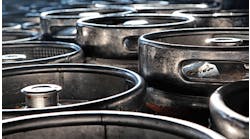Greg McMillan and Stan Weiner bring their wits and more than 66 years of process control experience to bear on your questions, comments, and problems. Write to them at [email protected].
Stan: The PID controller has been the workhorse of the process industry since the 1930s.
Greg: For unmeasured load disturbances and an unknown process, the PID controller offers an optimal solution if correctly tuned. In a 1976 landmark paper by Alan Bohl and Thomas McAvoy at the University of Massachusetts, a controller tuned for a minimum integral of time multiplied by absolute error (ITAE) provides the best response. Furthermore, Bohl and McAvoy found the PID achieves approximately the optimum ITAE response. Any further improvement required some knowledge of the process or disturbance. In a 1991 paper, F. Greg Shinskey showed the simple addition of a dead-time block in the external feedback path of the PID, based on knowledge of the loop dead time, could provide a dead-time compensator with a performance enhancement comparable to a model predictive controller and the Smith Predictor, without the need to know the process time constant and process gain, but with a tradeoff between performance and robustness. As you tune a controller for a faster response, it is more sensitive to process dynamics. Model predictive controllers and dead-time compensators are even more sensitive if they are tuned for hottest performance. For example, a dead-time compensator can develop a jagged response for a dead-time dominant loop if the dead time is either high or low by just 10% (See my "Review of Deminar #10—Dead-Time Compensator Myth Buster," http://tinyurl.com/3c426cr). However, implied in the best tuning of a PID controller is knowledge of the process dynamics, although it may be in terms of an ultimate period and ultimate gain obtained from heuristic methods or calculated by the automated relay tuning method.
Stan: The modern PID controller has a host of features such as the feed-forward multiplier and summer, nonlinear gain modification, integral dead band, velocity limits, forms and structures.
Greg: The positive feedback implementation of the integral mode (external reset feedback) offers an incredible variety of opportunities, including dynamic reset limit and an enhanced PID developed for wireless applications. Shinskey showcased the importance for slow loops and cascade control in the Control article "The Power of External Reset Feedback," (www.controlglobal.com/articles/2006/095.html).
The full power of the PID is under-utilized. One person who has achieved more innovative solutions than I have seen published in all of the articles by users is Mark Congiundi, engineering associate in process control at Sasol (www.sasol.com). Many of his remarkable improvements of the PID take advantage of the external reset feedback feature. In a recent two-hour interview, we discussed Mark's PID solutions, giving us enough material for a four-part series on advanced regulatory control (ARC). For details and ideas on how to get the most out of your automation system, I encourage you to attend Mark's presentations and the keynotes, general session and tutorials by Control's Process Automation Hall of Fame inductees (Charlie Cutler, Béla Lipták, myself, Terry Tolliver and Russ Rhinehart) at ISA Automation Week 2011.
Stan: What led to your expansive, creative use of PID controllers?
Mark: As a programmer of supervisory process control systems in the 1970s, I developed a holistic view, and developed a detailed understanding of the PID controller algorithm. When we rapidly moved into using distributed control systems, I took advantage of the infrastructure of the PID. The consistent interface of the PID is understood very well by the operators. The ability to manipulate setpoint, mode and manual output and, in some cases, limits is straightforward. The innovations often simply require additional configuration and, thus, are fast, low-cost solutions.
Greg: To minimize meter cost and to measure low flows, it is important to select a meter size to keep the velocity at low flows above the low limit. However, the capacity of the control valve may exceed the upper range of the flowmeter for large disturbances, or as production rates are increased beyond the original design for fluctuating demands and just-in-time manufacturing. How do you deal with the flow transmitter over-range problem?
Mark: The flow measurement just before the flow goes off-scale is captured and incremented by a controller output multiplied by a factor. The factor is the valve gain (∆flow/∆valve) that is the slope of the control valve's installed characteristic. It can be automatically identified by the change in flow for a change in valve position just before the flow went off-scale, or computed from sizing data and pressures. This same method could be used to extend the low-flow control limit, particularly for vortex meters whose signal drops to zero below minimum velocity.
Stan: All valves have some backlash where, upon a change in direction of the controller output, the valve does not change direction until the change in output exceeds the valve dead band. What do you do to eliminate the dead time from the controller output, having to traverse the dead band and the reduction in flow from the dead band portion of the change in output?
Mark: I boost the controller output change by half of the dead band whenever the output changes direction. This kicks the valve signal through the dead band, eliminating the dead time and providing the process with the missing flow response.
Greg: One of the best-kept secrets rediscovered periodically is the ability of a valve position controller (VPC) to optimize a process by controlling a valve position through precision manipulation of a process PID (see my blog post, "Valve Position Control," http://tinyurl.com/3mh65zr). The VPC is simply a PID whose process variable and setpoint are the current position and the desired position, respectively, of the process PID that is the constraint (limit) to improving process efficiency or capacity. Since an exact position does not need to be optimized, often the output of the process PID is used instead of a read-back of actual valve position. Of course, this assumes a true throttle valve with a good actuator and positioner are used, so there are no big offsets between the controller output and actual valve position. For example, a VPC reduces energy use by reducing compressor discharge pressure by pushing the furthest open feed valve to the maximum throttle position with just enough valve capacity and valve gain (slope of installed valve characteristic) for the flow loop to deal with disturbances and load changes. The VPC PID will interact with the primary process PID (e.g., compressor pressure) and secondary process PID (e.g., feed flow), so the VPC must be detuned.
The classic solution is an integral only (I-only) controller tuned to be 10x slower than the slowest process PID (e.g., compressor pressure PID). However, the process PID can get into trouble because the VPC is so slow. What do you do to ensure the VPC can help the process PID deal with large upsets, but not cause the VPC to fight with the process PID over control of the process (e.g., compressor) and valves (e.g., feed valves)?
Mark: I use an "enhanced position" for the VPC that is the target process PID output biased by a term indicative of a process PID's ability to do its job. The term is the square of the process PID error (with the sign retained) multiplied by a gain that determines the amount of the enhancement. The squaring of the error provides intelligence to ignore insignificant errors, but take aggressive action to help a process PID in trouble. The enhancement term is then added to or subtracted from the target process PID output depending on the process gain sign. The process PID whose error is used for the enhancement is usually the target PID, whose valve position is being optimized. However, the enhancement could come from any PID whose performance affects the efficacy of the VPC. Another PID may serve this role, and more than one PID may qualify. In these cases multiple terms with individual gains may be used.
Believe it or Don't
- A control valve specification actually stated the valve must respond
- Control valve stick-slip near the seat was the same as vendor tests at 50% open
- A control valve had a resolution and sensitivity better than the measurement
- A PID was tuned using a university text book for process input disturbance rejection
- A plant used all of the PID parameters and options
- A plant actually used all of the power of a Distributed Control System
- A level loop become unstable due to too high of a controller gain
- A level loop had a reset time that was too large
- An operator understood what a matrix predictive controller was doing
- A meeting was cancelled to get work done




